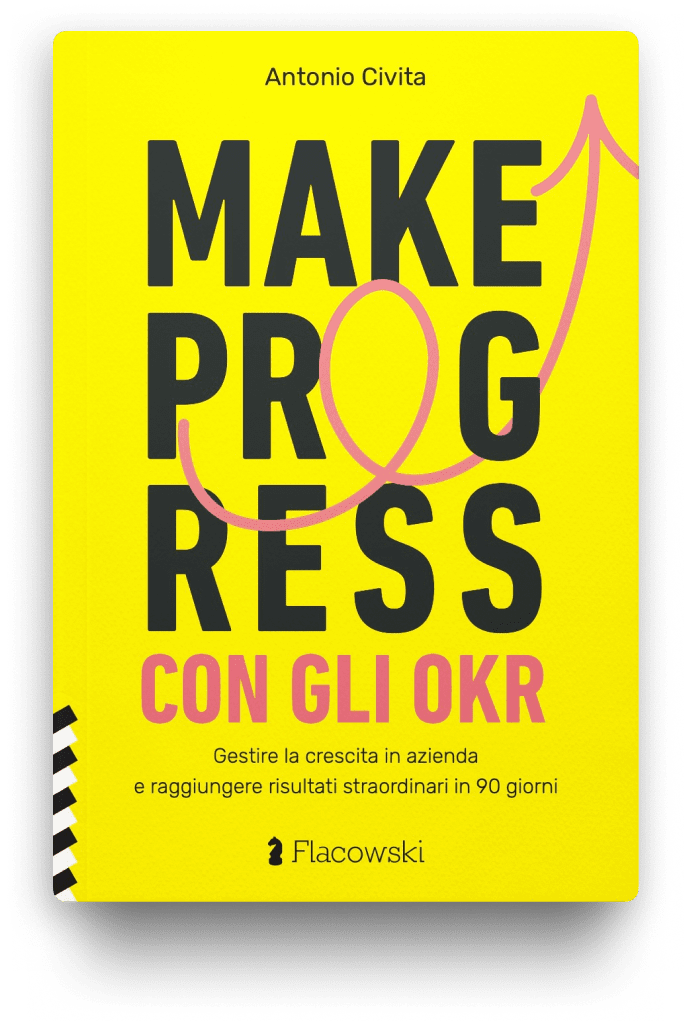Antò, it’s boiling!

The heat is rising, and with it comes the “phantom quarter,” that summer period when vacations are planned, concentration wanes, and all important decisions are put off until September. Your calendar is filled with meetings that could have been a 15-second audio message, and you feel that irretrievable fatigue. You and your team are still executing what was decided last December, but the numbers are not moving. You struggle not only to focus, but also to figure out what to focus your limited energy on.
This feeling of hopeless stagnation is not a symptom of poor work ethic or lack of commitment from your colleagues. It is a symptom of a completely broken priority management system. It is the direct consequence of managing a to-do list instead of executing a strategy.
In this edition, I want to share the basic principles of MAKE PROGRESS® that will enable you to diagnose your situation. My goal is not to give you a generic map, but to give you the framework to understand why you feel stuck. With these principles, you can use the summer not just to rest, but to update your company’s entire operating system and enter September with a clear plan of action.
Are you managing a huge to-do list or executing the strategy?

During a recent Office Hour, one of our practitioners shared a goal that had a key outcome like this: contact two new prospects per week.
That sounds perfectly reasonable, so much so that you could have one like that yourself, couldn’t you?
When your Key Result targets are so small, you are not driving a strategy; you are writing a to-do list.
Your team will just make the two contacts, and there will be no need for innovation, no pressure to find a better system. They will check the to-do box, and nothing in the way you work will change.
A goal with this form sounds more like a complaint than a strategic direction: “I wrote it as OKR, so now you have to do it.” But that is not the purpose of the strategic work we do here.
Now, imagine that the goal was different. For example: send 30,000 emails in one week. You can no longer simply “do it” as if you were sending two. The entire underlying process has to be reengineered. You are forced to think about scalability and repeatability right from the start.
How do you avoid this trap? The next time you set targets for your team, ask yourself this simple question, “To achieve this result, will my team have to work harder, or will they have to work differently?”
If the answer is just “work harder,” you have an assignment. It is an instruction. But if the answer is “work differently,” you have a strategic goal. You are asking them to create a new capacity, to change the scenario in which they will systematically achieve those results.
One is a task; the other is a transformation that becomes a permanent operational change for your business.
The real purpose of OKRs is to undermine the processes

Today everyone is talking about OKR, but in most cases, it is just a new name for an old bad habit: controlling employees to produce more.
I see this constantly. Companies take their existing KPIs, add a title, and call it an OKR. But an OKR is not simply a KPI on steroids. At MAKE PROGRESS®, we make a clear distinction: KPIs are about running the business, while OKRs are about changing the business.
A KPI measures the health of your current engine; an OKR is the plan to build a new, more powerful one. If your OKRs are not changing the way your business operates, they are not real OKRs at all.
As we said before, the real purpose of a well-formulated OKR is to put your current processes under such stress that they collapse. It is designed to make your current way of working obsolete. Think about it: if your team could achieve a truly ambitious goal simply by working harder or doing more of what they already do, would that be a strategic goal? I would say no! It would simply be-working a little harder because they were asked to. A real goal is one that your current system cannot handle. It puts your processes in crisis, and that crisis is a creative force. It forces your team to abandon the old way of doing things and invent something new and better. That’s where you create progress that lasts.
So here’s how you can make sure your next OKR is a transformational tool, not just a task. Before you even think about the numbers-the Key Results-I want you to write a single sentence that describes the qualitative effect you want to achieve. Start with the words, “We will have been successful when…” For example, “We will have been successful when our lead qualification process no longer relies on manual effort but on an automated system that delivers only high-level leads.” By first defining the transformation, you give your team a clear strategic direction. Only then ask, “What are the 2-3 numbers that will prove the existence of this new reality?” This simple change ensures that you are measuring a change in the business, not just the business as usual.
Give your team a problem, not the solution

Once you escape the trap of the to-do list, a new, more subtle challenge emerges. You find yourself in every meeting, feeling that if you are not there to make the decisions, projects get stuck and nothing moves forward. This is a frustrating position for a leader. It is also a direct consequence of accidentally training your team to wait for your solutions instead of developing their own.
When we, as leaders, continuously provide the “how,” we unwittingly signal to our teams that their main role is to follow instructions. We become the bottleneck of our own company and, in the process, forget why we hired them in the first place.
The most profound change a leader can make is to stop providing solutions and start defining problems very clearly. Your role is not to tell the team how to get to the destination; it is to tell them with absolute precision where the destination is and why it is important for everyone to get there.
Think of it this way: you are the captain who sets the course for a distant port, but your team members are the experts who actually sail the ship. If you spend your time telling them how to hoist the sails and read the charts, you are not only doing their job for them, you are failing to do yours: scanning the horizon to adjust course and avoid the iceberg!
Giving your team a well-defined problem is an act of trust; it shows that you respect their ability to reach the destination together.
Here is a simple experiment you can perform this week to start making this change. Before your next team meeting, look at your agenda. Identify any point where your intention is to tell your team what to do next. Now, rephrase it. Instead of presenting your plan, present only the goal. For example, instead of saying, “Here’s how we’re going to improve customer qualification,” try saying, “Our goal is to acquire only highly rated customers, which means our old process is no longer valid. How do you propose to build a new system to achieve this goal?” So, your only task is to listen. You will be amazed at the quality of the solutions your team develops when you give them the space to think.
Of course, identifying the few strategic issues that can truly transform your business is a discipline in itself. If you are looking for support at this stage, know that it will be the first thing we define together in a Roadmap session. You can request it for free here.
The myth of annual planning: a great strategy is built by connecting short cycles and long-term vision

One of the biggest wastes of resources in companies is the creation of the annual plan. Leaders feel obligated to produce this document, yet they struggle to define it. One year is a difficult horizon to work with; it is too distant for clear, tactical decisions, yet too close for truly visionary thinking. So what happens? You risk writing the same things over and over again, or you end up with a list of numbers disconnected from the work needed to achieve them.
When a practitioner recently told me how difficult it was to envision one-year goals, I fully understood that this ambiguous middle ground is where all good strategic intentions often get stuck, trapped between the urgencies of today and the ambitions of tomorrow.
In an agile environment, work is only discovered by doing it. That’s why, if you want to accelerate your progress, I suggest you take a shortcut that might seem counterintuitive to some: skip the one-year plan altogether.
Instead, your focus should be on maintaining a direct connection between only two time horizons: the immediate short-term and the ambitious long-term. The purpose of your three-year goal is not just to set a revenue target; its purpose is to ensure that you successfully build the essential assets of your future business. It is the answer to the questions:
- What critical capacity must our company possess in three years’ time that we do not have today?
- What fundamental system must be built to support our future growth, regardless of any single product or service we currently sell?
Here’s how to put it into practice. First, define that core capability will be needed by your team. Is it a proprietary control system? Is it a marketing engine that can scale in any market? Or a talent development program that creates future leaders? Once you have identified that capability, your short-term goal becomes simple: it is the very first piece of that system that you need to build now.
This concept is what we call an enabler in MAKE PROGRESS®, and it is the cornerstone for building a company that lasts. If you would like to learn more about how to identify and build them, you can find a detailed guide in my book or you can request a free session to identify them together.
The cast of a great performance starts with a power couple

You have done the hard work. The strategy is clear, the goals are set, and the path seems logical. But now you face the last and most practical qiestion: who exactly will lead this transformation within your company? This is where even the best plans can fail.
Leaders rightly worry about overloading their best people or choosing individuals who do not have the right skills to manage change of this magnitude. They fear that the strategy, however powerful, will become just another document that gets lost in the noise of day-to-day operations. This concern is understandable, because without a clear accountability structure, even the most brilliant strategy can soon become a reminder of failure.
The success of any great strategic performance depends on a “power couple” working in perfect harmony. We take inspiration from the world of film: a Director and a Producer.
The Director is the strategic architect, the one who defines the vision. This is often the founder or leader who must personally drive “vertical” growth, that is, the creation of an entirely new product or capability that does not yet exist. He is focused on inventing the future of the company.
The Producer, on the other hand, is the master of execution. His focus is on the “how.” He takes the Director’s vision and coordinates the resources, people and processes to make it a reality. He excels at driving “horizontal” growth, that is, taking a successful process and scaling it throughout the organization with discipline.
The Director writes how it will end; the Producer makes sure that the ending has no surprises.
To assign these roles in your company, look for these distinct behaviors. Who on your team is constantly exploring new market opportunities or working on innovation projects? That person has the instincts of a Director. And who is the person who, when presented with a goal, immediately starts organizing timelines, clarifying resources, and identifying potential obstacles to keep the team moving forward? That’s your Producer.
By formally associating them, you create a system in which the Director is free to design the future, while the Producer ensures that today’s business runs and grows smoothly. This is the first step in building a lean management system where progress no longer depends solely on you.
Let’s build your implementation roadmap together

Teams who work with us know the feeling of moving from the daily frustration of a routine based on untasking tasks to the clarity of a business built on strategic execution.
In this note, you discovered that progress is not about managing a longer to-do list, but about empowering your team with well-defined problems. You have seen that the purpose of an ambitious goal is to break your old processes, that your strategy must be built in rapid cycles connected with a long-term vision, and that successful performance requires identifying the right “power couple.” Now the final and most logical step is to translate these principles into a plan tailored to your business.
I invite you to take the next step with me. I have opened my calendar for a limited number of one-hour sessions where we can understand how MAKE PROGRESS® could be implemented in your company.
This is not a sales presentation; it is a working session. We will discuss your growth goals and evaluate together whether this system is a good fit for your current strategic challenges. The result will be a clear implementation roadmap that will show you how you can move from the static documents, dusty dashboards, and disconnected reports you rely on today to an agile and accurate growth management system that is goal-driven and measured with KPIs and OKRs.
If you are no longer willing to tolerate this chaos and are ready to engineer growth, visit this page to request your free Implementation Roadmap session.

